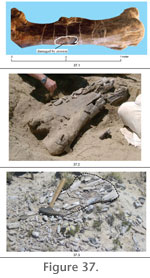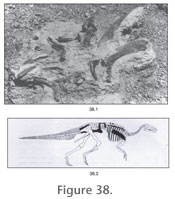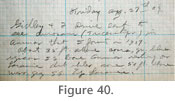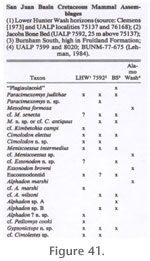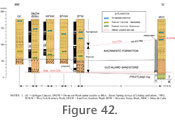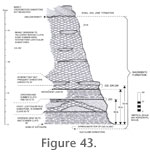|
|
|
VERTEBRATE PALEONTOGYVertebrate fossils have been known to exist in strata adjacent to the Cretaceous-Tertiary (K-T) boundary in the San Juan Basin since the work of Cope (1881). Subsequently, many vertebrate paleontologists visited the southern San Juan Basin and collected large numbers of vertebrate fossils in K-T strata that have been discussed and described in numerous publications up to the present day; for a list of the principal references to those publications see Williamson (1996), Fassett et al. (2002), and papers in Lucas and Heckert (2000). A detailed discussion of the history of vertebrate paleontology in the San Juan Basin is beyond the scope of this report but such discussions may be found in papers by Clemens (1973b), Fassett (1973), Powell (1973), Simpson (1981), and in Williamson (1996). This report focuses on the biochronologic significance of vertebrate fossils from the Paleocene Ojo Alamo Sandstone, Animas Formation, and the lowermost part of the Nacimiento Formation, with brief discussions of vertebrates from underlying Cretaceous strata. Vertebrate paleontology has had limited biochronologic value in determining the age of strata adjacent to the K-T interface in the San Juan Basin. However, with the publication of a series of six radiometric ages throughout the Cretaceous Fruitland and Kirtland Formations (Fassett and Steiner 1997; Fassett 2000), the precise ages of the vertebrate assemblages in these strata have now been established. This temporal calibration of Late Cretaceous (Campanian) vertebrates in the San Juan Basin provides a standard to correlate faunal zones of the San Juan Basin to other Western Interior basins where such data sets may be less complete. Dating of the Paleocene Ojo Alamo Sandstone on the basis of robust palynologic data and, independently, on the basis of paleomagnetism (Fassett and Lucas 2000, Fassett et al. 2002, and this report) has now established the Paleocene age of this formation and its contained vertebrate-fossil assemblage: the "Alamo Wash local fauna.. Correlation of these Paleocene vertebrates to other North American basins may improve our understanding of the survival of various "Lancian"-aspect vertebrates across the Cretaceous-Tertiary interface. DinosaursCretaceous Kirtland and Fruitland Formations. Dinosaurs of the Fruitland and Kirtland Formations in the San Juan Basin were summarized in Lucas et al. (2000, p. 87, 88). Sullivan and Lucas (2006, p. 18-20) also presented a detailed analysis of the dinosaur taxa identified from these formations and defined their new "Kirtlandian" land vertebrate age as being "equivalent to 2.2 m.y. of Campanian time" falling between the Judithian and Edmontonian land-vertebrate ages of the northern part of the Western Interior of North America. Sullivan and Lucas (2006) is an amplification of the Sullivan and Lucas (2003) paper in which the "Kirtlandian" name was first proposed.
Fassett and Lucas stated that because this fossil was so massive and its outer surface so pristine (Figure 37.1), this bone could not possibly have been reworked from underlying Cretaceous strata into the high-energy, conglomeratic, Ojo Alamo Sandstone, and they wrote (p. 228): "We suggest that the hadrosaur represented by this femur lived in early Paleocene time and died near the place where this specimen was found." The Paleocene age of the Ojo Alamo Sandstone at the San Juan River site (reported in Fassett and Lucas 2000) was established by the presence of Paleocene index palynomorphs in the lower Ojo Alamo, below the level of the hadrosaur femur. A sample of this hadrosaur femur was chemically analyzed and found to have distinct elemental concentrations characteristic of Paleocene dinosaur bone in the San Juan Basin. (The chemistry of Cretaceous vs. Paleocene dinosaur-bone samples from the San Juan Basin is discussed in detail in a subsequent section of this report.) Sullivan, Lucas, and Braman (2005, p. 401) discussed the hadrosaur femur from the Ojo Alamo Sandstone at the San Juan River site, as follows: However, despite the bone's near-pristine appearance, we argue here, largely based on parsimony [my emphasis], that the bone has been reworked, and not transported any significant distance, thereby preserving the integrity of the bone's outer surface. Three points are relevant to this suggestion that this specimen is "reworked": 1) The femur was found 15 m above the base of the Ojo Alamo Sandstone in an area where the contact of the Ojo Alamo Sandstone and the underlying Kirtland Formation is essentially a planar surface; there is no conceivable way this bone could have been weathered out of the underlying Cretaceous strata and been redeposited 15 m above the base of the Ojo Alamo without moving it a "significant distance"; 2) The word "parsimony", as used above apparently means adherence to the concept that dinosaurs are defacto Cretaceous index fossils; it is suggested that adherence to this precept, in the face of overwhelming physical evidence to the contrary, is not parsimonious; 3) The hadrosaur femur's chemistry strongly suggests that it is a Paleocene bone (see the "Geochemistry of Vertebrate Bone Sample" section of this report). Sullivan, Lucas, and Braman (2005) offer no new evidence contravening these facts. With the exception of the San Juan River locality, all dinosaur remains from the Ojo Alamo Sandstone are from the southwestern part of the San Juan Basin between Hunter Wash and Betonnie Tsosie Wash (Figure 1, Figure 3). Within this region, the highest concentration of dinosaur bone is in the Ojo Alamo Sandstone type area: from just west of Hunter Wash to just east of De-na-zin Wash (Figure 4). Dinosaur fossils have also been found relatively recently in the Ojo Alamo Sandstone southeast of the type area near Betonnie Tsosie Wash (Figure 11). Fassett et al. (2002) discussed and referenced all significant published reports of dinosaur fossils from the Ojo Alamo Sandstone and listed the following dinosaurs from that formation (as reported by Lucas et al. 2000, p. 88): Alamosaurus sanjuanensis; ?Albertosaurus sp., cf Tyrannosaurus sp.; ankylosaurid, indeterminate; dromaeosaurid, indeterminate; hadrosaurids, indeterminate; nodosaurids, indeterminate; ornithomimid, indeterminate; Pentaceratops; saurornithoidids, indeterminate; Torosaurus cf. T. latus. The "Pentaceratops" specimen was reexamined (Sullivan, Boere, and Lucas 2005, p. 567), and these authors determined that this fossil should be relabeled "chasmosaurine, indeterminate." Glyptodontopelta mimus, according to R.M. Sullivan (personal commun., 2006) should be added to the list along with Tyrannosauridae, indeterminate. Sullivan, Boere, and Lucas (2005) indicated that all specimens from the Ojo Alamo originally named Torosaurus were incorrectly identified and suggested that the name Torosaurus be replaced by "chasmosaurine, indeterminate." Farke (2002), however, indicated that specimen NMMNH P.22884 from the Ojo Alamo is the ceratopsian Torosaurus cf T. utahensis , thus this name is retained in the list of Ojo Alamo dinosaurs. Specimen NMMNH P.25074 was originally reported to be from the Ojo Alamo Sandstone) and was referred to Torosaurus sp. by Farke (2002). Sullivan, Boere, and Lucas (2005), however, stated that this specimen was from the uppermost Kirtland Formation, not the Ojo Alamo Sandstone, and moreover determined that this specimen was not Torosaurus and should thus be labeled "chasmosaurine, indeterminate." Sullivan (personal commun., 2006) suggested that the name "saurornithoidids, indeterminate" be removed from the dinosaur-fossil list of Lucas et al. (2000) reproduced above. Williamson and Weil (2001) listed additional dinosaurs identified from vertebrate microfossil sites in the Ojo Alamo Sandstone (their "Naashoibito Member" of the Kirtland Formation), as follows: At the top of the Kirtland Formation, the Naashoibito Member (Alamo Wash local fauna) has yielded teeth of, in decreasing order of abundance, ceratopsids, titanosaurids, hadrosaurids, tyrannosaurids including cf. T. rex, and species of Troodon and Richardoestesia distinct from those of from (sic) the Fruitland and lower Kirtland Formations. Thus, a revised list of dinosaur specimens identified from the Ojo Alamo Sandstone is: Alamosaurus sanjuanensis; ?Albertosaurus sp., cf Tyrannosaurus sp.; ankylosaurid, indeterminate; dromaeosaurid, indeterminate; Glyptodontopelta mimus; hadrosaurids, indeterminate; nodosaurids, indeterminate; ornithomimid, indeterminate; Richardoestesia sp.; cf titanosaurids, indeterminate; Torosaurus cf T. utahensis; Troodon sp.; Tyranosaurus rex; and tyrannosaurid, indeterminate. Many of the dinosaur fossils identified from the dozens of known occurrences in the Ojo Alamo Sandstone in the Ojo Alamo type area and elsewhere in the San Juan Basin are labeled "indeterminate" because nearly all specimens are single limb bones or parts of bones that cannot be identified as to genus and species. Some of these single bones are pristine and beautifully preserved, such as the hadrosaur femur from the San Juan River locality (Figure 37.1). Figure 37 shows three Ojo Alamo Sandstone dinosaur fossils in various stages of preservation ranging from being virtually perfectly preserved (Figure 37.1) to partially or nearly totally fragmented (Figure 37.2-3); much of the dinosaur bone found in the Ojo Alamo is in the latter category. In at least one locality (sample 020103, locality H, Figure 4), bone fragments from several animals are preserved in a paleo channel-lag deposit. The disintegration of dinosaur bone, as it weathers from its matrix, subaerially, (Figure 37) offers a compelling argument against the reworking of intact dinosaur bones from underlying strata into higher strata. Such reworking would require the weathering-out of such bones, intact and unabraded, from their original matrix, millions of years after their original entombment, and then require that they be transported long distances laterally to a place topographically lower but stratigraphically higher than the original bone site. The fragmentation and dispersal of the weathered dinosaur fossils of Figure 37.2-3 shows why such a scenario is unlikely to impossible. Even the pristine hadrosaur femur from the San Juan River site was beginning to degrade as it weathered out of the cliff face where it was found (Figure 37.1), and its continued erosion would have resulted in the total fragmentation and destruction of this specimen. A commonly proposed scenario for reworking fossils from older into younger strata supposes that on a high-relief surface, a channel scour might undercut a topographically higher exposure of older strata resulting in a bone encased in that strata being dropped into a channel of younger age. This very unlikely scenario, however, would result in the displaced bone's being emplaced in the younger strata within a disoriented exotic block of rock that would be clearly apparent. The large hadrosaur bone from the San Juan River site was definitely not encased in an exotic block of Cretaceous strata because, as discussed above, uppermost Cretaceous strata in the San Juan Basin are invariably fine- to medium-grained, whereas, Ojo Alamo strata are coarse-grained and conglomeratic. Figure 7 of Fassett et al. (2002) contains a photograph of the San Juan River site hadrosaur femur in place; that photograph clearly shows this fossil encased in coarse-grained conglomerate that is clearly an integral part of the surrounding rock strata. Moreover, none of the dozens of other dinosaur bones found in the Ojo Alamo in the southern part of the basin are contained in down-dropped exotic blocks. It would thus seem that the down-dropped-block scenario for all of the many dinosaur bones in the Ojo Alamo Sandstone at numerous localities in the San Juan Basin is not realistic.
The question of possible reworking of the many single-bone dinosaur specimens found in the Ojo Alamo Sandstone was addressed by Fassett et al. (2002). These authors presented chemical analyses of Cretaceous and Paleocene dinosaur-bone samples showing that critical elemental concentrations in them were distinctive. An additional 14 bone samples were subsequently analyzed; six from the Ojo Alamo Sandstone, six from the Kirtland Formation, and two not in place. These chemical analyses showed a higher abundance of uranium and a lower abundance of rare-earth elements (REE) in Paleocene bone samples and lower uranium and higher REE concentrations in Cretaceous bone samples. The distinctly different chemical "fingerprints" indicate that the Paleocene dinosaur bones were mineralized in place in the Ojo Alamo Sandstone in early Paleocene time and thus could not represent bones that had been reworked from underlying Cretaceous strata. One of the Paleocene bones chemically analyzed was a scapula from the 34-bone assemblage from a single hadrosaur, discussed above. (The geochemistry of dinosaur-bone samples from strata adjacent to the K-T interface is summarized below in the "Geochemistry of Vertebrate Bone Samples" section of this report.) The biochronologic age of dinosaur bones from the Ojo Alamo Sandstone has been much debated over the years: Some workers have assigned a Lancian age to these fossils (Lucas et al. 1987, Hunt and Lucas 1992, Weil and Williamson 2000, and Williamson and Weil 2001, for example). Other workers (Lucas et al. 2000, p. 88), however, state that whereas the "conventional view" is that the Ojo Alamo dinosaur bones are "of Maastrichtian age, or Lancian in terms of vertebrate biochronology" a "reasonable alternative" for the age of these fossils is that they are "late Campanian". Conclusions by Sullivan, Boere, and Lucas (2005) and Sullivan, Lucan, and Braman (2005) are far less equivocal stating that the Ojo Alamo dinosaur fossils are "early Maastrichtian" in age or "near the Campanian-Maastrichtian boundary." Farke and Williamson (2006 p. 1019), on the other hand, concluded that the biochronologic age of the Ojo Alamo Sandstone (their Naashoibito Member of the Kirtland Formation) based on both dinosaur and mammal fossils was Lancian. They stated: We consider the Naashoibito Member and the Alamo Wash local fauna to be of latest Cretaceous age (Lancian land-mammal age) based on the presence of cf. T. rex (Carr and Williamson 2000) and the Lancian index mammal Essonodon browni (Lehman 1984; Williamson and Weil 2003). This correlation refutes a late Campanian or early Maastrichtian age for the Naashoibito Member (e.g., Sullivan, Lucas, and Braman [2005]). Paleocene Animas Formation. Knowlton (1924) identified fossil leaves from Animas Formation collections from 24 numbered localities. The stratigraphic levels of these localities ranged from about 60 m above the base of the Animas to near its top more than 500 m above the base of the formation. Knowlton (p. 71) concluded that based on these fossils the Animas Formation was "undoubtedly Tertiary." Because of the antiquity of Knowlton's (1924) study of fossil leaves in the Animas Formation, K. Johnson, with the Denver Museum of Nature and Science, Denver, Colorado, was asked to review Knowlton's faunal lists from the Animas Formation and Knowlton's conclusion that this floral assemblage was indicative of a Paleocene age for the Animas. Johnson reported (personal commun., 2008): "I would conclude that the Animas is probably early Paleocene." Newman (1987), as discussed above, reported that the Animas Formation near Durango, Colorado, was Paleocene based on its contained palynomorphs.
The principal published references to dinosaurs found in the Animas Formation in the northern San Juan Basin are in Reeside (1924; p. 32, 34, and 52-53). Unfortunately, Reeside did not provide specific localities for any of the dinosaur-bone sites he referred to, other than "near the divide between the Pine and Piedra rivers" for one of them. There is no evidence that any of the Animas Formation dinosaur fossils referred to by Reeside were ever collected.
Apparently the presence of dinosaur fossils in the Animas Formation was common knowledge among vertebrate paleontologists working in the area at that time, as indicated in a paper by Simpson (1950, p. 86). In this report, Simpson stated that "Dinosaurs have been found in middle and lower parts of the Animas in Colorado . . ." Simpson, however indicated that the "Cretaceous-Tertiary transition occurs within this formation [Animas], at an undetermined level." Simpson clearly thought that the K-T boundary should be placed above the highest dinosaurs in spite of Knowlton's (1924) assertion that the Animas Formation was Paleocene based on fossil leaves. Simpson (1950, p. 85) is known to have worked on the Paleocene in the San Juan Basin for the American Museum beginning in 1929. Simpson's colleague at the American Museum, Walter Granger, had worked in the basin in 1912 through 1914 and in 1916. And another colleague, J.W. Gidley, had visited a ceratopsian bone site with Reeside in 1909 (Figure 40). It is probable that Granger and USGS geologists Reeside and Gardner also made field trips together and may have even visited Animas-Formation, dinosaur-bone localities together in the northern part of the San Juan Basin. The reference to Gidley in Gardner's field notes (Figure 40) clearly indicated that the American Museum staff of vertebrate paleontologists was well aware of the presence of dinosaurs discovered in the Animas Formation by USGS geologists. Although no dinosaur-bone locality has been located in the Animas Formation in modern times, there can be no doubt that these localities do exist and thus remain to be rediscovered. Reeside (1924, p. 32 and Appendix) concluded that: In view of the wide differences in opinion expressed by various students as to the correct assignment of this whole group of related formations, the Ojo Alamo sandstone and Animas formation are herein classified as Tertiary (?). This conclusion by Reeside (1924) was startling and not a trivial one. Reeside had done field work throughout the San Juan Basin for many years, had measured thousands of meters of section through all of the rocks adjacent to the Cretaceous-Tertiary interface, and was well aware of the abundance of dinosaur bone in the Ojo Alamo Sandstone in the southern San Juan Basin and in the Animas Formation in the northern San Juan Basin. Reeside was certainly well aware of the significance of dinosaur bone as a Cretaceous index fossil in terrestrial strata in the Western Interior of North America. In spite of this, Reeside concluded that the Animas and Ojo Alamo were "Tertiary (?) in age." (It is suggested that Reeside's query may have been added to mollify vertebrate paleontologists and/or USGS editors of his time.) Reeside's discussions of the data in his 1924 USGS Professional Paper leave no doubt that he considered the Ojo Alamo and Animas Formations to be Tertiary in age. It is thus clear that Reeside, in 1924, was the first known geologist to challenge (albeit tacitly) the thesis that all dinosaurs became extinct at the end of the Cretaceous. This discussion of dinosaur fossils in the Paleocene Animas Formation provides powerful, additional, independent evidence that dinosaurs lived in the San Juan Basin area in early Paleocene time. These findings, that have been slumbering in the published (and unpublished) literature for more than 80 years, seem to have been overlooked or ignored by nearly all subsequent workers in the San Juan Basin. Fassett et al. (2002) briefly referred to Reeside's (1924) mention of Animas dinosaurs, however this report amplifies Reeside's work and adds additional supporting data from Gardner's 1909 field notes and Simpson's 1950 paper. MammalsCretaceous Strata. Most of the mammalian fossils discovered in Cretaceous strata in the San Juan Basin have been recovered relatively recently using screen-washing techniques to primarily recover mammal teeth. Clemens (1973b) was the first paleontologist to conduct a concerted and extensive search for fossil mammals in upper Cretaceous strata in the San Juan Basin. He worked primarily in the southwestern part of the basin in Fruitland and Kirtland Formation strata near the Bisti Trading Post (since burned down, Figure 3), and he compiled the first list of mammal fossils from these strata. Clemens considered these mammals to be part of his "Hunter Wash local fauna" writing (p. 164) that this fauna had a "unique composition" and questioned whether this fauna differed from other faunas of the same age due to ecological or biogeographic differences "or some combination of these factors?" Clemens (1973b, p. 154) concluded that the temporal significance of his Hunter Wash local fauna was uncertain because it contained genera and species "in association with animals also known from the type Lance local fauna (Clemens 1964, 1973a), the fauna of the upper part of the Edmonton Formation (Lillegraven 1969), and those recovered from the Judith River (Sahni 1972) and Milk River formations (Fox 1970)." Clemens concluded that "Differences in local faunal composition are probably the results of both biogeographic provinciality and inequality in age." Lindsay et al. (1981) added no new mammal identifications from the Fruitland-Kirtland interval, but based on a review of Clemens (1973b) mammal list, stated (p. 422) that the Hunter Wash fauna "includes some and lacks other mammals" characterizing the Lancian Land Mammal Age and concluded that this fauna was late, but not latest Cretaceous. This reinterpretation of the temporal significance of Clemens (1973b) mammal fauna (a bolder and quite different interpretation from that of Clemens, as noted above) was one of the lines of evidence that convinced Lindsay et al. (1981) that there was no unconformity at the base of the Ojo Alamo Sandstone and thus (mistakenly) convinced these authors that deposition had been continuous across the Cretaceous-Tertiary interface in the San Juan Basin. Fassett and Steiner's (1997) discovery of a 40Ar/39Ar single-crystal sanidine age of 73.04 ± 0.25 Ma for an altered volcanic ash bed (Ash J of Figure 4) in the uppermost part of the Kirtland Formation (less than 5 m below the base of the Ojo Alamo Sandstone) in the Hunter Wash area refuted the assertion of Lindsay et al. (1981) that uppermost Cretaceous strata in the Hunter Wash area "represent latest Cretaceous." Flynn (1986) reported on fossil mammals collected between 1975 and 1978 in conjunction with the field studies of Lindsay et al. (1981). The Cretaceous collections came from two areas labeled on Figure 3 as: FBS (Flynn Burnham South); and FK (Flynn Kirtland). The FBS locality is in the middle to upper part of the Fruitland Formation in the southwestern part of the San Juan Basin, southeast of the Burnham Trading Post (Figure 3). The FK locality consists of sites in the lower part of the Kirtland Formation west of Alamo Wash; these sites were apparently discovered by Lindsay et al. (1978, figure 2). Flynn listed his and previously published Cretaceous mammal identifications of Clemens (1973b) in his table 3.
Flynn (1986, table 3,
Figure 41 of this report),
Flynn's colleagues (Lindsay et al. (1981)), however, had concluded that the Hunter Wash local fauna was in the upper part of paleomagnetic chron C31n and the lower part of C30n suggesting according to Flynn (1986, p. 28) that this faunal assemblage was from strata "equivalent to the late Maastrichtian with an age of about 68 Ma" Flynn (1986, p. 28) opted to side with the geophysical data, concluding that: "The most parsimonious correlation of the normal magnetozones, without the prejudice of biochronological assumptions, is with anomalies 30 and 31." (It is now known that anomalies 30 and 31 of Lindsay et al. (1981) are really magnetochrons C32r and C33n, respectively.) Rigby and Wolberg (1987) conducted an extensive study of microvertebrates collected from a small area in the southwestern part of the San Juan Basin known as the Fossil Forest area. The Fossil Forest mammal quarry is about 18 km southeast of the Bisti area (Figure 3) where Clemens (1973b) did his collecting and about 12 km southeast of the Alamo Wash area where Flynn (1986) collected. The Fossil Forest collections came from the lowermost Kirtland Formation and thus are at about the same stratigraphic level as Clemens' and Flynn's Lower Hunter Wash collection sites. Rigby and Wolberg (1987, p. 51) determined that their collections were most closely related to faunas of Sahni (1972) from the Judith River Formation and those of Fox (1977, 1979a, 1979b, 1979c, and 1981) from the Oldman Formation—a Judith River equivalent. These authors thus concluded that "The age of the lowermost part of the Kirtland Shale must be near the Campanian-Maastrichtian boundary based on mammalian evidence." As discussed above, the age of the contact between the Fruitland Formation and overlying Kirtland Formation is now known to be 74.6 Ma in the Ojo Alamo Sandstone type area (Figure 33); the precise age of dated ash 4 at about this level is 74.55 ± 0.29 Ma (Fassett and Steiner 1997, Fassett 2000). The latest published global geologic time scale (Gradstein et al. 2004) puts the Campanian-Maastrichtian boundary at 70.6 Ma. Thus, the mammal assemblages of Clemens (1973b) and Rigby and Wolberg (1987), as well as the Lower Hunter Wash mammalian fauna of Flynn (1986), can now be confidently placed in the upper Campanian with an age of 74.6 Ma; about 4 m.y. older than the Campanian-Maastrichtian boundary. Sullivan and Lucas (2006, p. 20-21) discussed the latest Cretaceous and earliest Paleocene mammals of the southern San Juan Basin, but added nothing new to the above discussion. No other studies of Cretaceous mammals from the San Juan Basin have been published since the Rigby and Wolberg (1987) paper. Paleocene Strata. The Ojo Alamo Sandstone has yielded relatively few mammal-fossil localities in the San Juan Basin, despite extensive searches in that formation over the last three decades. Lehman (1984) was the first paleontologist to report a small collection of fossil mammals from the lowermost part of the Ojo Alamo Sandstone (his Naashoibito Member of the Kirtland Formation) in the type area (Figure 3). Lehman assigned a Lancian Age to the Ojo Alamo because his collection contained a multituberculate tooth identified as Essonodon browni. Flynn (1986) identified microvertebrates from the Ojo Alamo (his Naashoibito Member of the Kirtland) less than 2 km southeast of the Lehman (1984) site (Figure 3). Flynn named this assemblage the Alamo Wash fauna and included in it Lehman's Essonodon browni (Figure 41). Flynn (1986, p. 26-27) concluded that: "Mammals from these high Kirtland strata appear to represent the Lancian age, based on co-occurrence of Essonodon browni (see Lehman 1984), Alphadon marshi, and Mesodma formosa." Weil and Williamson (2000) presented preliminary data from an Ojo Alamo Sandstone microvertebrate site about 1 km north of the Lehman (1984) mammal site (Figure 3). They discussed the total vertebrate assemblage from this site, including dinosaurs, and stated that the Lancian index fossil Essonodon was the most common mammal found in the Ojo Alamo. They also noted that Essonodon was "relatively rare in localities of the northern Western Interior, and the striking difference in relative abundance confirms speculation that latest Cretaceous southern mammalian faunas differ markedly from those of the northern Western Interior, as do dinosaurian assemblages." Clemens and Williamson (2005, p. 212) cautioned that the geochronologic value of fossil mammals in Western North America is in a state of flux. They stated that the record of mammalian evolution in the North American Western Interior is not yet complete as evidenced by "Fox and Naylor's (2003) recent description of a new taeniodont from Alberta [that] extended the range of this eutherian lineage from the Puercan (Pu2) back into the Lancian." These authors also noted that the multituberculate Stygimys that first appears in the northern part of the Western Interior at the beginning of the Puercan (Pu1) "is a member of a local fauna of Judithian age in Baja California del Norte (Weil 2002)." The cautionary statements of these authors regarding the current state of uncertainty about the biochronologic status of various fossil mammals because of the "incompleteness of the fossil record" are well advised. Moreover, these uncertainties tend to make less incredible the findings in this paper that the fossil mammals of the Ojo Alamo Sandstone (previously thought to be "Lancian") are Paleocene in age. These mammal assemblages thus represent lineages that survived across the K-T boundary. It seems clear that the use of fossil mammals as index fossils for dating lower Paleocene strata in the Western Interior of North America is premature at this time because of: 1) limited numbers of collection sites; 2) biogeographic diversity of taxa; and 3) limited knowledge of the evolution and radiation of mammals in earliest Paleocene time. The use of more robust geochronologic tools, such as palynology and isotopic and paleomagnetic dating of strata, as done in this study to confirm the Paleocene age of the Ojo Alamo Sandstone in the San Juan Basin, will ultimately help us to better understand the biogeographic and temporal diversity of mammals found near the K-T boundary throughout the Western Interior. Lowermost Nacimiento Formation. As discussed above, the Nacimiento Formation intertongues with the underlying Ojo Alamo Sandstone; thus, on the basis of physical stratigraphy, it appears that deposition was continuous across this formation boundary. These formations are, however, distinctly different lithologically: the Ojo Alamo is characterized by massive, coarse-grained, conglomeratic sandstone beds deposited by high-energy braided streams flowing south to southeastward across the San Juan Basin in early Paleocene time (Fassett 2000, Fassett et al. 2002). The Nacimiento Formation, however, at least in its lowermost part, consists of relatively finer-grained sediments deposited in a low-energy environment of low-gradient streams interspersed with lakes and swamps. This difference suggests that the pulse of high-energy stream flow represented by the Ojo Alamo Sandstone began suddenly about 65.2 Ma -300 k.y. into Paleocene time - and ended abruptly a few hundred thousand years later. Such a pulse must have been driven by a corresponding rapid uplift and then subsequent subsidence of a northern source area. Williamson (1996) published a detailed paper on the stratigraphy and mammalian biostratigraphy of the Nacimiento Formation in the southern San Juan Basin that included a series of detailed measured sections through the Nacimiento at selected localities (Williamson 1996, appendix 1, p. 110-126). Williamson reported that Puercan (earliest Paleocene) mammals had been found in the lowermost part of the Nacimiento Formation at five localities in the southwestern part of the San Juan Basin between Gallegos Canyon and Betonnie Tsosie Wash (Figure 3).
Figure 42 is
On Figure 42, the DNZW, BTW, and MDC columns are aligned on the base of magnetochron C29n (base projected for the BTW column). Column GC is aligned with column DNZW on the top of the Ojo Alamo Sandstone. Column WFKW is aligned with the DNZW column on the top of chron C29n. Column EFKW is aligned with the WFKW column on the top of the Ojo Alamo Sandstone. These alignments of the six columns appear to be quite reasonable in terms of the good correlation of the Puercan and Torrejonian fossil levels reported at the six localities. The magnetic-polarity columns shown at the DNZW, WFKW, and the BTW localities are from Lindsay et al. (1981). (The DNZW section of Williamson is at the same locality as the Barrel Spring Arroyo (BSA) locality of Lindsay et al. 1981.) The top of magnetic-polarity chron C29n at the MDC locality was estimated based on a rate of deposition for the lower part of the Nacimiento Formation of 143 m/m.y. This rate was calculated based on the 40Ar/39Ar age of 64.40 ± 0.50 Ma for the youngest sanidine crystals from an altered volcanic ash bed found at the MDC locality (Fassett et al. 2007, Heizler personal commun., 2008). The level of this ash bed is shown on the MDC column on Figure 42. Williamson numbered the magnetic polarity chrons on his figure 9 based on the reinterpretation of these chrons suggested by Butler and Lindsay (1985). These magnetic-polarity intervals, however, are renumbered on Figure 42 in accordance with the reevaluation of these chrons as discussed in detail in the "Paleomagnetism" section of this paper. Williamson (1996, p. 27) stated that there are two faunal zones within the Puercan of the Nacimiento Formation in the southern San Juan Basin: a lower Ectoconus zone and an upper Taeniolabis zone. Figure 42 shows the Ectoconus zone present at four localities and the Taeniolabis zone at two localities; both zones are found together at only the DNZW locality where the Ectoconus zone was found only 10 m above the top of the Ojo Alamo Sandstone. These two zones appear to overlap very slightly at the DNZW and the EFKW localities (Figure 42).
The Puercan-Torrejonian boundary can thus be placed fairly precisely in the lower part of the Nacimiento Formation (Figure 42) between the lowest Torrejonian mammal level at the MDC locality and the highest Puercan mammal level at the GC locality. The age of this boundary is estimated to be about 64.4 Ma because it is near the top of chron C29n which has an age of 64.432 Ma (Gradstein et al. 2004). Thus, the Puercan in the San Juan Basin has a duration of about 1.1 m.y., ranging from the base of the Paleocene at 65.5 Ma to the Puercan-Torrejonian boundary at 64.4 Ma (Figure 42). The Torrejonian mammals identified in the lower part of the Nacimiento Formation in the five sections all appear to fall within magnetochron C28n. The lower of the two Torrejonian fossil localities at the MDC site, however, appears to be in chron C28r or the uppermost part of chron C29n (Figure 42). A paleomagnetic survey of the Nacimiento Formation at Mesa de Cuba would supply a valuable data set to clarify these interpretations. The level of the interpolated top of magnetochron C29n at the MDC locality is higher than the top of this chron at the DNZW, WFKW, and BTW localities (Figure 42). This anomaly must be the result of different rates of deposition for the lower Nacimiento Formation at these widely separated localities. (The apparent rate of deposition for the part of the lowermost Nacimiento within chron C29n is estimated to be 102 m/m.y. at the DNZW locality vs. 143 m/m.y. at the MDC locality.) Chron C28r is anomalously thin at the BTW locality and Lindsay et al. (1981, p. 417) suggested that this thinness is the result of present-day-normal overprinting of the lower part of normal interval C28n due to weathering beneath recent sand dunes at the BTW locality. Additional paleomagnetic studies are clearly needed in the BTW area to help clarify this paleomangnetic pattern. Clemens and Williamson (2005) discussed the Puercan fauna at the Betonnie Tsosie Wash (BTW) locality (Figure 11 and Figure 42). They named a new species, Eoconodon ginibitohia, based on a fragment of a left dentary collected at the lowermost level for Puercan mammal fossils at that locality (Figure 42). These authors asserted that based on correlations of this taxon with other Eoconodon species in the northern part of the Western Interior, it, and the other mammals found in the "Ectoconus zone" of the southern San Juan Basin, belong in the "Pu2 Interval Zone" (middle part of the Puercan). They further stated that (p. 208): "Earliest Paleocene, Pu1 Interval Zone faunas are unknown in the San Juan Basin." It is here suggested that part of the missing lower "Puercan Pu1 Zone" in the San Juan Basin may be represented by the Paleocene Ojo Alamo Sandstone mammals, discussed above. And, as discussed elsewhere in this report, as much as 300 k.y. of earliest Paleocene time apparently is not represented by rock strata in the San Juan Basin, thus at least the lowermost part of the "Pu1 Interval Zone" is missing for that reason. Clemens and Williamson (2005, p 209) placed the Ectoconus zone fauna in the lower part of magnetochron C29n in the San Juan Basin. However, as Figure 42 shows, Ectoconus-zone mammals are present throughout the upper half of chron C29n at the four localities where it has been found in the lowermost part of the Nacimiento Formation. The presence of the middle Puercan Pu2 Interval Zone ("Ectoconus zone") in the lowermost Nacimiento Formation at the DNW locality (within 5 or 10 m of the top of the Ojo Alamo Sandstone; Lindsay et al. 1981 and Williamson 1996, respectively) suggests that the upper part of the "Pu1 Interval Zone" may be within the Ojo Alamo Sandstone providing additional strong evidence for continuous deposition across the Ojo Alamo-Nacimiento contact and in agreement with the Paleocene age of the Ojo Alamo Sandstone. |
|
